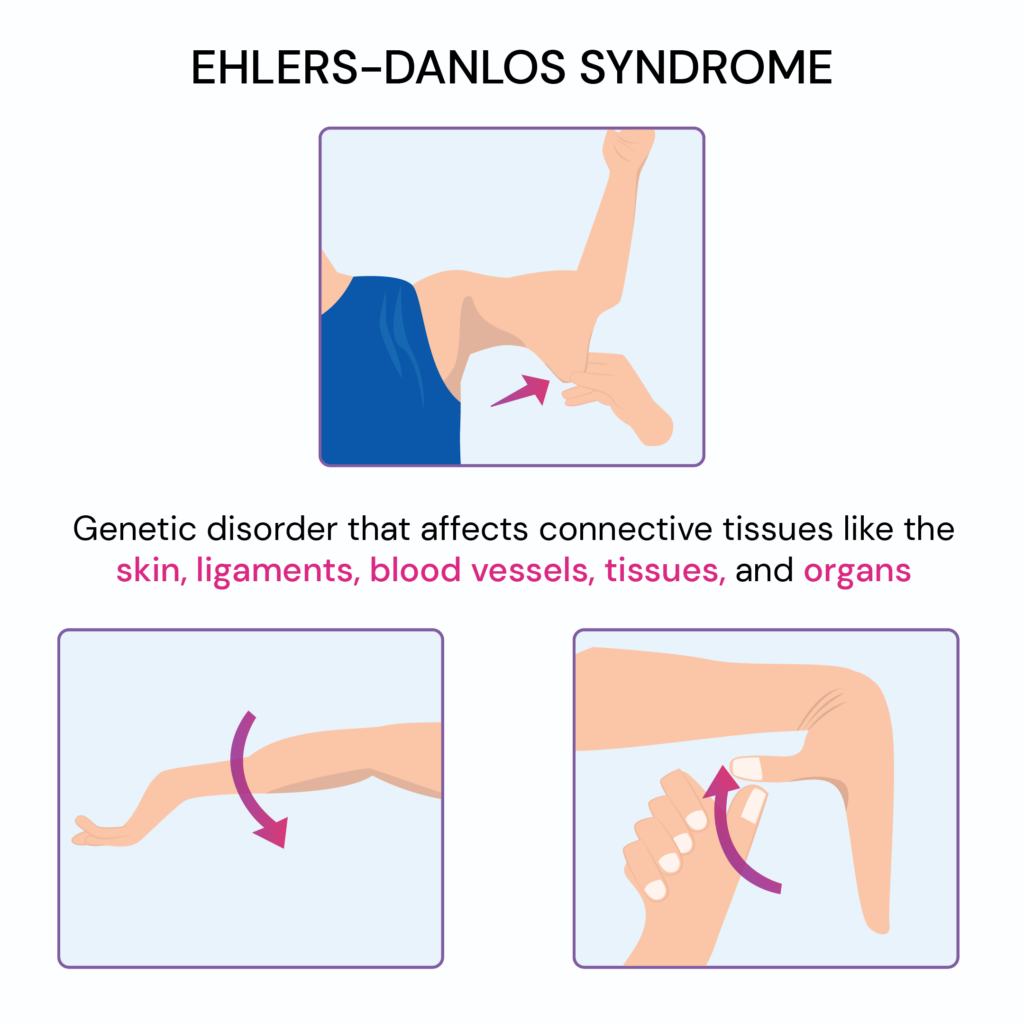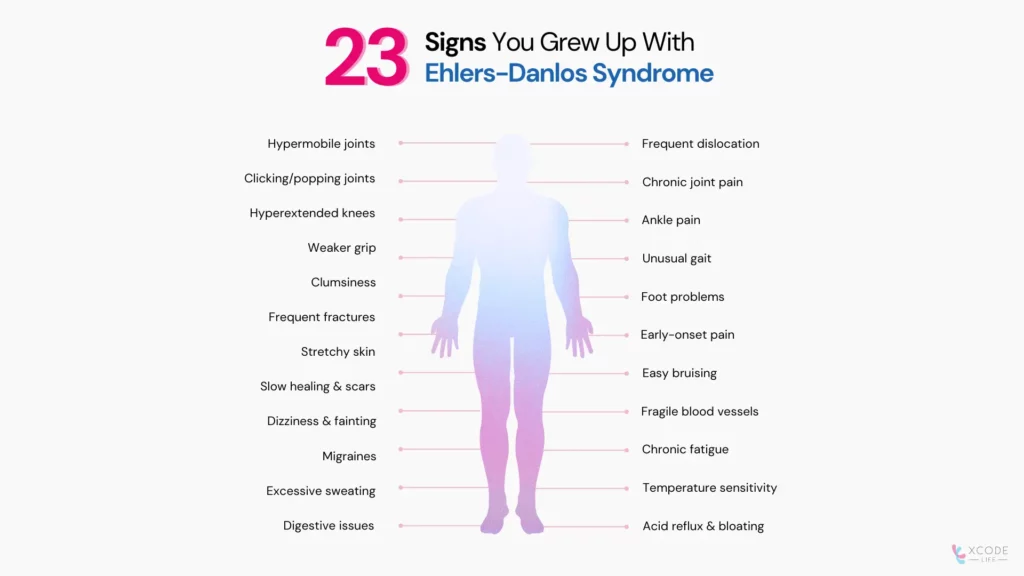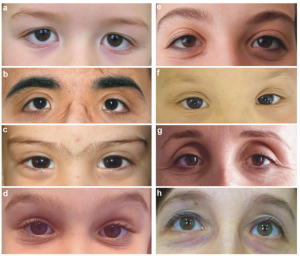Key Takeaways
Ehlers-Danlos syndrome (EDS) is a group of rare genetic conditions that affects connective tissue, which provides structure and support to the joints, skin, blood vessels, and internal organs. In EDS, genetic changes alter collagen, a protein essential for tissue strength and flexibility, making tissues fragile and joints prone to looseness or instability. These changes can lead to frequent injuries, slow healing, and challenges in everyday activities, as even minor pressure or strain may cause damage.

23 Signs You Grew Up With Ehlers-Danlos Syndrome
Joint & Musculoskeletal Symptoms
- Hypermobile joints (double-jointed flexibility)
- Frequent joint dislocations
- Clicking or popping joints
- Chronic joint pain and instability
- Hyperextended knees
- Ankle pain during growth
- Weak grip strength (e.g., difficulty opening jars)
- Clumsiness and uncoordinated movements
- Frequent foot problems
- Higher fracture risk
- Chronic pain beginning at a young age
Skin & Wound Healing Issues
- Soft, stretchy skin
- Easy bruising
- Slow wound healing and prominent scars
- Fragile blood vessels; prone to injury
- Excessive sweating
Nervous System & Autonomic Symptoms
- Dizziness and fainting (often linked to POTS)
- Chronic fatigue
- Frequent migraines
- Sensitivity to temperature changes
Digestive & Other Symptoms
- Acid reflux and bloating
- Nausea, constipation, or diarrhea
Common Signs Of EDS And Their Causes
| Sign | Likely cause | Notes |
| Hypermobile joints | Weak connective tissue | Core diagnostic sign |
| Easy bruising | Fragile blood vessels | Appears even with minor trauma |
| Slow wound healing | Collagen defects | May leave “cigarette paper” scars |
| Dizziness/fainting | Autonomic dysfunction (POTS) | Common in hypermobile EDS |
| Digestive issues | Weak connective tissue in gut | Acid reflux, constipation, bloating |
What Do Experts Say About EDS?
Dr. Blair Grubb, a cardiologist specializing in autonomic disorders at Ohio University Health Sciences, highlights:
- Hypermobility as a key diagnostic sign
- Cognitive issues in some patients
- 78% of those with asymptomatic hypermobility showed abnormal autonomic test results
- Higher rates of autism spectrum conditions in EDS patients
“We see EDS as not just a joint condition but a systemic one that can involve the nervous system, skin, and even cognition.”
*Asymptomatic hypermobility: A condition where a person's joints can move more than usual (are extra flexible), but they don't experience any pain or problems because of it.
**Autonomic test results: The outcomes from medical tests that check how well the body's automatic systems—like heart rate, blood pressure, and digestion—work.

Types of Ehlers-Danlos Syndrome
There are 13 known subtypes of EDS, ranging from common to rare. Some of the main ones include:
- Hypermobile EDS (hEDS): Most common; marked by joint instability, chronic pain, and dizziness.
- Classical EDS: Caused by variants in COL5A1 or COL5A2 genes, leading to stretchy skin and poor wound healing.
- Vascular EDS: Linked to COL3A1 mutations; affects blood vessels and carries serious risks.
- Kyphoscoliotic EDS: Rare; marked by severe spine curvature.
Is Ehlers-Danlos Syndrome Genetic?
Yes, EDS is caused by variants in genes that produce collagen or proteins that support connective tissue.
| Gene | Associated EDS type | Function |
| COL5A1 / COL5A2 | Classical EDS | Collagen type V production |
| COL3A1 | Vascular EDS | Collagen type III production |
| COL1A1 / COL1A2 | Classical & rare types | Collagen I production |
| TNXB | Classical-like EDS | Tenascin-X protein (supports connective tissue structure) |
Explore your ancestry test raw DNA data
Certain gene changes can put you at higher risk for developing many chronic conditions like diabetes, hypertension, and even scoliosis. Learning about your genetic risks can help plan prevention strategies even before the symptoms appear.
Please note: Xcode Life does not test for Ehlers-Danlos Syndrome
How Is Ehlers-Danlos Syndrome Diagnosed?
- Clinical exam: Beighton score (≥5/9 in adults) for hypermobility, skin extensibility, and scarring.
- Family history: Many forms follow autosomal dominant inheritance.
- Genetic testing: Available for classical, vascular, and some rare types.
- Differentiation: EDS is distinct from Marfan syndrome (tall stature, heart risks) and fibromyalgia (chronic pain without tissue fragility).
The Diagnosis Conundrum: EDS vs. Marfan vs. Fibromyalgia
EDS, Marfan Syndrome, Fibromyalgia, and Joint Hypermobility Syndrome share overlapping symptoms like joint hypermobility and chronic pain.
However, EDS is marked by fragile connective tissue, skin hyperextensibility, and frequent dislocations, while Marfan Syndrome typically includes tall stature and cardiovascular issues.
Fibromyalgia focuses on widespread pain without connective tissue abnormalities, and Joint Hypermobility Syndrome lacks the systemic features seen in EDS.
Accurate diagnosis relies on detailed clinical evaluation and genetic testing.
What Are The Treatments For Ehlers-Danlos Syndrome?
There is currently no cure for EDS, but treatment helps manage symptoms and limit complications.
Therapies & rehabilitation
- Physical therapy helps improve joint stability and prevent dislocations.
- Occupational therapy can make daily activities safer and easier.
- Braces and supportive devices may be recommended for weak joints.
Medications & medical care
- Pain relief with over-the-counter or prescribed medications.
- Blood pressure management in certain types to reduce strain on fragile vessels.
- Surgery may be considered for severe joint damage or organ complications, though healing can be challenging.
Counseling & genetic guidance
- Psychological support for coping with chronic pain and lifestyle changes.
- Genetic counseling to discuss family planning and inherited risks.
Lifestyle adjustments
- Mindfulness, relaxation techniques, and stress management can improve quality of life.
- Low-impact activities such as cycling, swimming, or tai chi are preferred over contact sports or heavy lifting.
- Supportive footwear and ergonomic seating help protect joints.
- Sleep aids such as body pillows or firm mattresses may improve comfort.
- A balanced diet and supplements (vitamin D, B12, and iron) may be used under medical supervision.
Note: Everyone’s health situation is different. The details shared here are for general awareness, not a replacement for professional care. Please consult a healthcare provider to find out what works best for you.
Holistic Approach To EDS Management*
Diet and Supplements
- Anti-inflammatory focus: Prioritize whole foods like leafy greens, antioxidant-rich fruits, and omega-3 sources (salmon, walnuts) to reduce inflammation.
- Nutrient support: Address common deficiencies in vitamin D (bone health), B12 (cognitive function), and iron (fatigue) through fortified foods or supplements under medical guidance.
- Gut health: Include prebiotics (garlic, bananas) and probiotics (yogurt, kefir) to improve digestion and reduce gastrointestinal symptoms1.
- Individualization: Tailor diets to comorbidities (e.g., gluten-free for celiac disease, low-carb for diabetes).
Environment
- Ergonomics: Use supportive seating, joint braces, and adaptive tools to minimize strain on hypermobile joints.
- Sensory considerations: Reduce triggers for mast cell activation (MCAS) by avoiding allergens and fragrances. Air purifiers can also help improve indoor air quality.
- Compression garments: Can help improve blood flow and reduce symptoms like dizziness or fatigue
Workout And Mindfulness
- Low-impact exercise: Focus on swimming, Pilates, or resistance training to strengthen muscles without stressing joints.
- Timing: Avoid exercise for at least an hour post-meal to prevent autonomic dysfunction flare-ups.
- Physical therapy: Customized programs to stabilize joints and improve proprioception.
- Stress reduction: Meditation and breathing exercises can alleviate anxiety and chronic pain.
- Cognitive-behavioral strategies: Address the emotional toll of EDS through guided therapy or journaling.
*For informational purposes only. These strategies may work well for some than others. It is not advisable to start any supplements without consulting a qualified medical practitioner. A healthcare professional can provide guidance based on your unique circumstances and health profile. Always prioritize professional guidance when considering lifestyle and environmental changes.
Can EDS And Autism Co-occur?
Yes, research suggests there are overlapping genetic factors and comorbidities.
Shared features include sensory sensitivities, digestive problems, and coordination issues.
ADHD, anxiety, fibromyalgia, and mast cell activation syndrome (MCAS) are also reported in both conditions.
Overlapping Symptoms
Symptomatically, both conditions share features such as:
- Sensory sensitivities: Individuals with EDS and autism often experience heightened sensitivity to light, sound, or touch.
- Motor coordination challenges: Joint hypermobility in EDS can lead to proprioceptive issues**, similar to motor difficulties seen in autism.
- Gastrointestinal problems: Digestive issues like irritable bowel syndrome are common in both conditions
**Proprioception is also called kinesthesia. It is the body's awareness of its position and movement in space, which is crucial for coordination and balance.
Overlapping Comorbidities
- ADHD: Attention-deficit/hyperactivity disorder (ADHD) is frequently reported alongside both EDS and autism. Shared neurological pathways may explain this overlap.
- Anxiety: Anxiety is common in both groups. In EDS, it’s often linked to chronic pain or autonomic dysfunction. In autism, it can stem from sensory overload or social stress.
- Fibromyalgia: Chronic pain and fatigue in fibromyalgia mimic symptoms in EDS and autism, making diagnosis tricky. These conditions all involve heightened sensory sensitivity and nervous system dysregulation.
Mast Cell Activation Syndrome (MCAS): MCAS, more common in EDS, can cause flushing, GI issues, and chemical sensitivities. Some researchers are exploring whether similar immune responses occur in autism too.
FAQs On Signs Of Ehlers-Danlos Syndrome
What Are Unusual Symptoms Of EDS?
Stretchy skin, fragile vessels, chronic pain, frequent dislocations, and dizziness from POTS are some lesser-known signs.
What’s The Life Expectancy Of Someone With EDS?
For most types of EDS, life expectancy is normal if managed well.
In vascular EDS, however, the median life span is around 48 years because of risks like artery or organ rupture.
Life expectancy may also be reduced in kyphoscoliosis EDS due to vascular and lung complications.
Can EDS Worsen With Age?
Yes, flexibility may decrease over time, while chronic pain, fatigue, and joint instability often worsen.
What Are The Red Flags Of EDS?
Unusually flexible joints, family history, delayed wound healing, and fragile skin are key red flags.
Does EDS Affect Hair?
Yes, EDS can indirectly affect hair. Altered collagen and skin structure in EDS can lead to enlarged hair follicles, which may affect hair quality.
Additionally, some patients may experience thinning or brittle hair due to nutritional deficiencies.
What Are The Facial Features Of EDS?
Some people with vascular Ehlers-Danlos syndrome may have thin, translucent skin, a narrow or thin nose, a thin upper lip, small earlobes, and prominent eyes.
In fair-skinned individuals, underlying blood vessels may be clearly visible through the skin.
Can EDS Affect Breasts?
Yes. Fragile connective tissue can make breasts more prone to pain, strain, or injury, especially with changes in weight or pressure.
What Can EDS Be Mistaken For?
Marfan syndrome, Loeys-Dietz syndrome, fibromyalgia, and joint hypermobility syndrome.
Do People With EDS Look Younger?
Some appear younger due to soft, elastic skin, though fragility and scarring are also common.
Is Ehlers-Danlos A Chronic Condition?
Yes. Symptoms are lifelong, and chronic pain is reported in about 90% of patients.
Expert-recommended pick

Ehlers Danlos Syndrome & The Eyes
Summary: 23 Signs You Grew Up With Ehlers-Danlos Syndrome
EDS is a rare group of genetic conditions caused by collagen-related gene variants. Symptoms can range from joint instability and fragile skin to digestive problems and chronic fatigue. With 13 recognized types, hypermobile EDS is the most common. While EDS has no cure, early recognition, lifestyle support, and personalized medical care can greatly improve quality of life.
References
- https://themighty.com/topic/ehlers-danlos-syndrome/signs-growing-up-with-ehlers-danlos-syndrome-eds/
- https://www.yahoo.com/news/22-signs-grew-hypermobility-002742611.html
- https://www.nhs.uk/conditions/ehlers-danlos-syndromes/
- https://www.actifypt.com/post/7-symptoms-of-ehlers-danlos-syndrome-that-google-wone28099t-tell-you-about
- https://blog.cincinnatichildrens.org/rare-and-complex-conditions/ehlers-danlos-syndrome-the-lengthy-road-to-diagnosis/
- https://www.ehlers-danlos.com/what-is-eds/






